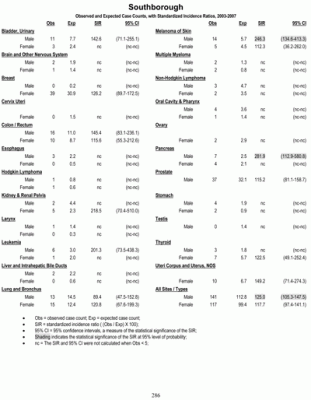According to a report released earlier this year by the Massachusetts Office of Health and Human Services, 141 men in Southborough and 117 women were diagnosed with cancer from 2003 to 2007. It’s a statistic that earns Southborough the dubious honor of being one of the towns in Massachusetts with the highest rates of cancer.
In a ranking of Massachusetts communities, Southborough had the eighth highest cancer rate over the 5-year period, with 285 incidents of cancer compared to the statewide average of 212.
Southborough’s men fared worse than its women according to the report. Compared to other communities, men in Southborough had a statistically significant higher rate of cancer overall, and a significantly higher rate of melanoma and pancreatic cancer in particular.
The most common type of cancer diagnosed in Southborough men was prostate cancer (37 cases compared to the statewide average of 32). For Southborough women breast cancer was the most common diagnosis (39 cases compared to the average of 31).
Communities with a higher cancer incidence rate than Southborough include Cohasset (#7), Provincetown (#6), Norfolk (#5), Petersham (#4), Marshfield (#3), Hull (#2), and Nantucket (#1). See a slideshow of the top 50 communities here.
You can view the complete report on the EOHHS website, but I’ve excerpted the Southborough numbers below (click to enlarge).

The report doesn’t attempt to explain why the rate is higher in Southborough than other towns. What do you make of the numbers? Are they a quirk of our particular demographics, or something more? Share your thoughts in the comments.
(Thanks to My Southborough reader Clare for pointing me to this report.)


That is rather disturbing. According to some quick glancing at http://maps.massgis.state.ma.us/map_ol/oliver.php the percent 65 and older in Southborough does not appear to be anywhere near the top 20 towns (or even 50, if I’m reading it right).
Does anyone have any scientific explanation for this? I don’t know about the rest of you, but I find this very disturbing and would like to know more about how our town got so high on the list.
It would be interesting if they would dig deeper into an explanation and expand the timeframe to look back over the years. We have always thought the cases of cancer are higher than average in town.
My sister in law is an epidemiologist with experience studying geographic cancer locations and here’s what she had to say when I showed her this story…
“Cancer includes many different diagnoses, all with different characteristics and risk factors; however, some basic principles apply to all cancers.
Cancer incidence usually espressed as a rate is defined as the number of
new cases occurring in a population during a defined time interval.
Incidence rates are a useful measure of the risk of disease. Cancer incidence is based on people’s residence when the cancer was diagnosed. Rates for a geographical area are measured by comparing the number of cancers diagnosed in residents to the number of people in the same area, and adjusting for age.
While incidence rates are a way of understanding whether one population’s
cancer experience is different than another population’s, they only reflect the number of new cases of cancer diagnosed. Cancer “prevalence” is the number of people alive today who have ever been diagnosed with cancer. This includes individuals who are newly diagnosed, in active treatment, have completed active treatment, and those living with progressive symptoms of their disease. Cancer is, unfortunately, very
common. Roughly one out of every two men and one out of every three women
will develop cancer in their lifetime.
Melanoma has known risk,factors of UV exposure (including indoor tanning). Pancreatic cancers have primarily lifestyle risk factors of smoking, diabetes, obesity but also family history and genetics.
Prostate cancer is the most common male cancer. Breast cancer is the most
common female cancer. Both of these types of cancers are activly “screened” for. Lung cancer is usually number one overall when you combine males and females.
As a group of more than 100 diseases, different types of cancers have different causes, and different rates of occurrence. Different types of cancers in a community do not necessarily have the same cause. As Americans we are living longer, cancer of one type or another is an increasingly common diagnosis. Each type of cancer is caused by a different set of factors, some well established, some uncertain, and some
unknown. The exact causes of most cancers are unknown. Most geographic differences in cancer rates appear to result from behavioral differences or differences in lifestyle, not from anything in a persons physical surroundings or from environmental pollution.”